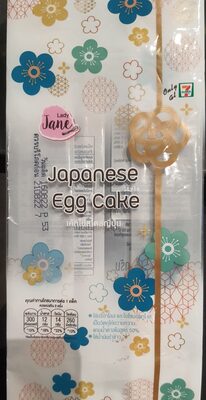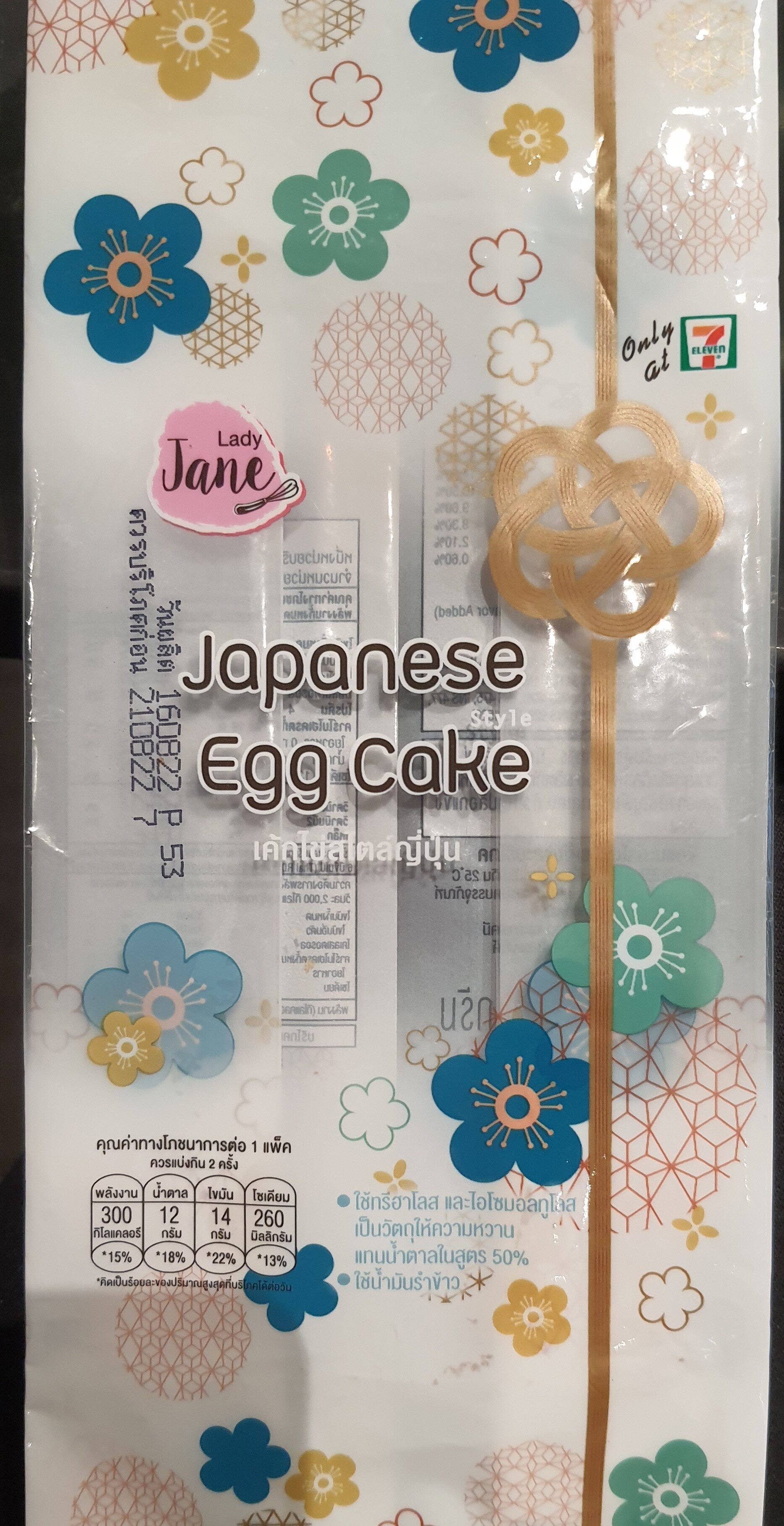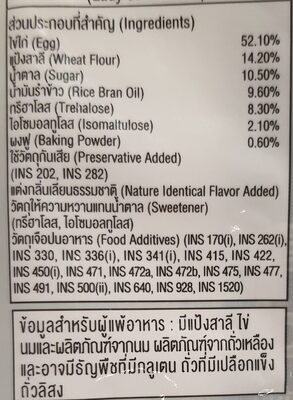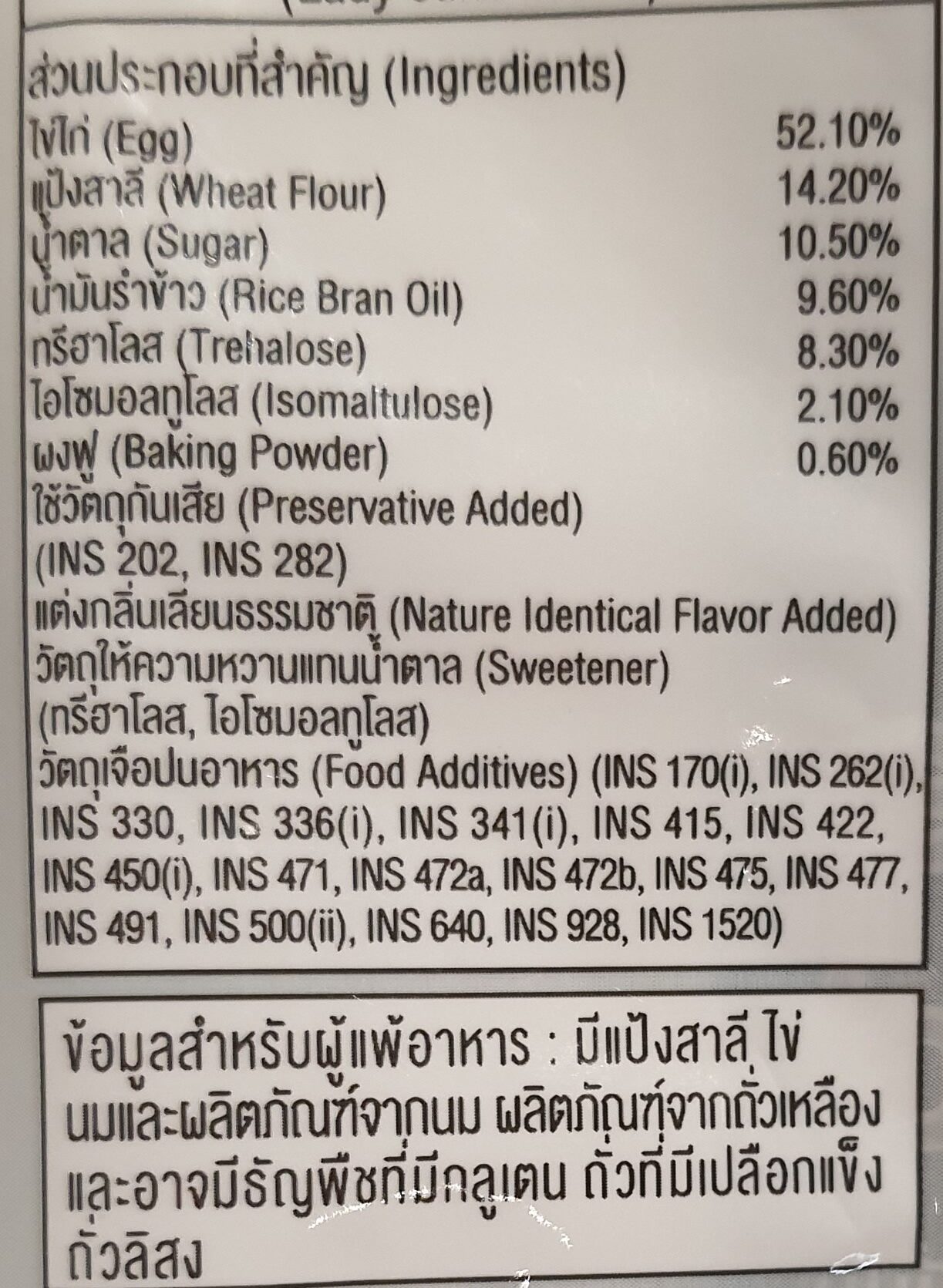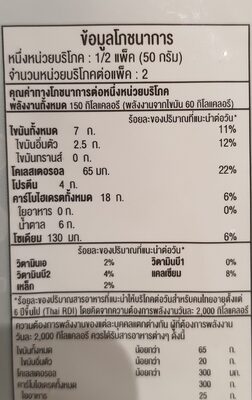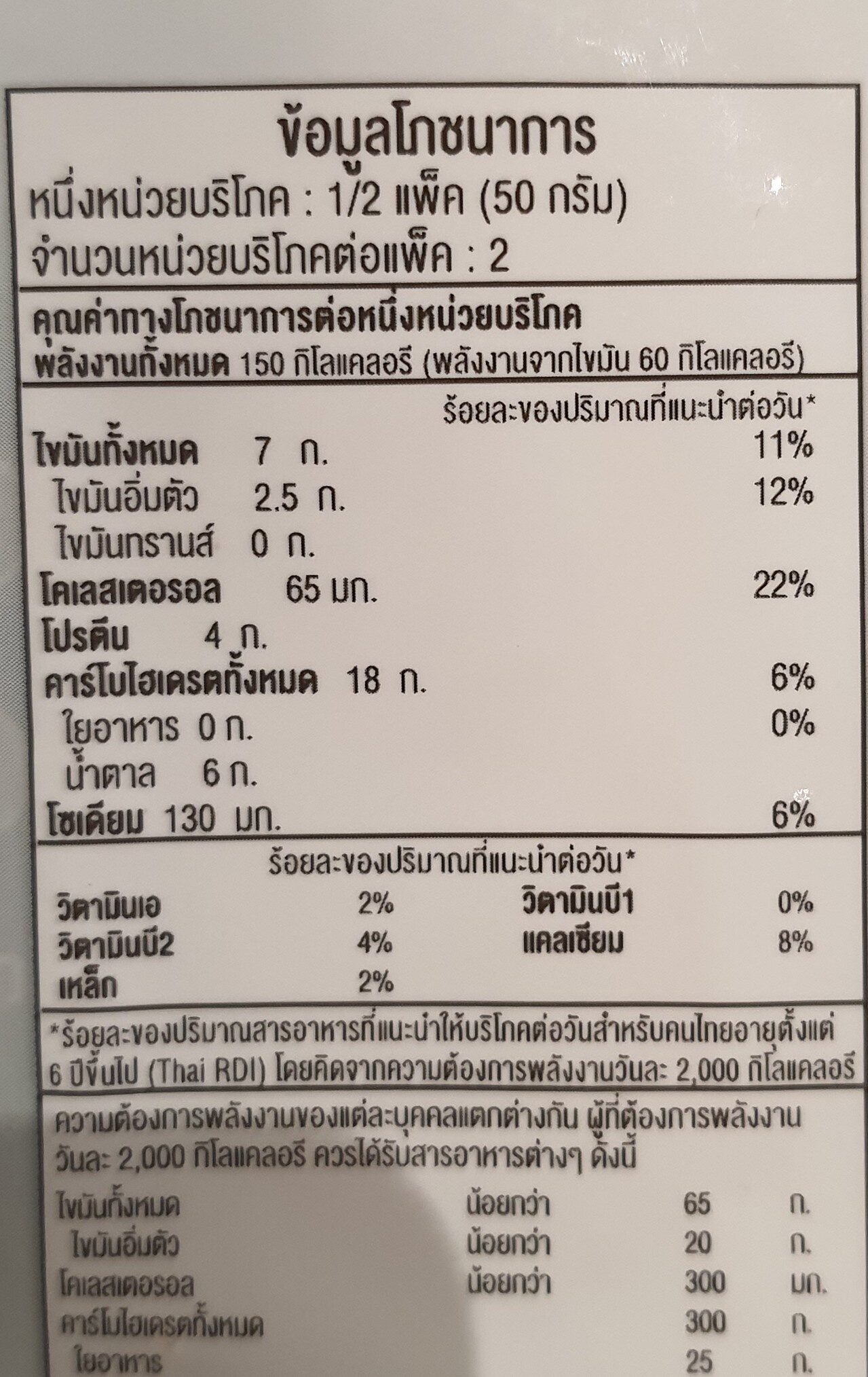Help us make food transparency the norm!
As a non-profit organization, we depend on your donations to continue informing consumers around the world about what they eat.
The food revolution starts with you!
เค้กไข่สไตล์ญี่ปุ่น - Lady Jane - 100 g
เค้กไข่สไตล์ญี่ปุ่น - Lady Jane - 100 g
This product page is not complete. You can help to complete it by editing it and adding more data from the photos we have, or by taking more photos using the app for Android or iPhone/iPad. Thank you!
×
Barcode: 8851351950504 (EAN / EAN-13)
Quantity: 100 g
Packaging: Bag
Brands: Lady Jane
Categories: Snacks, Desserts, Sweet snacks, Biscuits and cakes, Cakes
Countries where sold: Thailand
Matching with your preferences
Health
Ingredients
-
45 ingredients
: ไข่ไก่ (Egg) 52.10% แป้งสาลี (Wheat Flour) 14.20% น้ำตาล (Sugar) 10.50% น้ำมันรำข้าว (Rice Bran Oil) 9.60% ทรีฮาโลส(Trehalose) 8.30% โอโซมอลทูโลส (Isomaltulose) 2.10% ผงฟู (Baking Powder) 0.60% ใช้วัตถุกันเสีย (Preservative Added) (INS 202, INS 282) แต่งกลิ่นเลียนธรรมชาติ (Nature Identical Flavor Added) วัตถุให้ความหวานแทนน้ำตาล (Sweetener) (กรีฮาโลส, ไอโซมอลทูโลส) วัตถุเจือปนอาหาร (Food Additives) (INS 170(i), INS 262(1), INS 330, INS 336(i), INS 341(i), INS 415, INS 422, | INS 450(i), INS 471, INS 472a, INS 472b, INS 475, INS 477, INS 491, INS 500(ii), INS 640, INS 928, INS 1520)Allergens: Eggs, Gluten, Milk, Nuts, Peanuts, SoybeansTraces: Eggs, Gluten
Food processing
-
Ultra processed foods
Elements that indicate the product is in the 4 - Ultra processed food and drink products group:
- Additive: E170 - Calcium carbonates
- Additive: E415 - Xanthan gum
- Additive: E422 - Glycerol
- Additive: E450 - Diphosphates
- Additive: E471 - Mono- and diglycerides of fatty acids
- Additive: E472a - Acetic acid esters of mono- and diglycerides of fatty acids
- Additive: E472b - Lactic acid esters of mono- and diglycerides of fatty acids
- Additive: E475 - Polyglycerol esters of fatty acids
- Additive: E477 - Propane-1‚2-diol esters of fatty acids
- Additive: E491 - Sorbitan monostearate
- Additive: E640 - Glycine and its sodium salt
Food products are classified into 4 groups according to their degree of processing:
- Unprocessed or minimally processed foods
- Processed culinary ingredients
- Processed foods
- Ultra processed foods
The determination of the group is based on the category of the product and on the ingredients it contains.
Additives
-
E170 - Calcium carbonates
Calcium carbonate: Calcium carbonate is a chemical compound with the formula CaCO3. It is a common substance found in rocks as the minerals calcite and aragonite -most notably as limestone, which is a type of sedimentary rock consisting mainly of calcite- and is the main component of pearls and the shells of marine organisms, snails, and eggs. Calcium carbonate is the active ingredient in agricultural lime and is created when calcium ions in hard water react with carbonate ions to create limescale. It is medicinally used as a calcium supplement or as an antacid, but excessive consumption can be hazardous.Source: Wikipedia
-
E202 - Potassium sorbate
Potassium sorbate (E202) is a synthetic food preservative commonly used to extend the shelf life of various food products.
It works by inhibiting the growth of molds, yeast, and some bacteria, preventing spoilage. When added to foods, it helps maintain their freshness and quality.
Some studies have shown that when combined with nitrites, potassium sorbate have genotoxic activity in vitro. However, potassium sorbate is generally recognized as safe (GRAS) by regulatory authorities.
-
E262 - Sodium acetates
Sodium acetate: Sodium acetate, CH3COONa, also abbreviated NaOAc, is the sodium salt of acetic acid. This colorless deliquescent salt has a wide range of uses.Source: Wikipedia
-
E330 - Citric acid
Citric acid is a natural organic acid found in citrus fruits such as lemons, oranges, and limes.
It is widely used in the food industry as a flavor enhancer, acidulant, and preservative due to its tart and refreshing taste.
Citric acid is safe for consumption when used in moderation and is considered a generally recognized as safe (GRAS) food additive by regulatory agencies worldwide.
-
E336 - Potassium tartrates
Potassium tartrate: Potassium tartrate, dipotassium tartrate or argol has formula K2C4H4O6. It is the potassium salt of tartaric acid. It is often confused with potassium bitartrate, also known as cream of tartar. As a food additive, it shares the E number E336 with potassium bitartrate.Source: Wikipedia
-
E336i - Monopotassium tartrate
Potassium tartrate: Potassium tartrate, dipotassium tartrate or argol has formula K2C4H4O6. It is the potassium salt of tartaric acid. It is often confused with potassium bitartrate, also known as cream of tartar. As a food additive, it shares the E number E336 with potassium bitartrate.Source: Wikipedia
-
E341 - Calcium phosphates
Calcium phosphate: Calcium phosphate is a family of materials and minerals containing calcium ions -Ca2+- together with inorganic phosphate anions. Some so-called calcium phosphates contain oxide and hydroxide as well. They are white solids of nutritious value.Source: Wikipedia
-
E341i - Monocalcium phosphate
Calcium phosphate: Calcium phosphate is a family of materials and minerals containing calcium ions -Ca2+- together with inorganic phosphate anions. Some so-called calcium phosphates contain oxide and hydroxide as well. They are white solids of nutritious value.Source: Wikipedia
-
E415 - Xanthan gum
Xanthan gum (E415) is a natural polysaccharide derived from fermented sugars, often used in the food industry as a thickening and stabilizing agent.
This versatile food additive enhances texture and prevents ingredient separation in a wide range of products, including salad dressings, sauces, and gluten-free baked goods.
It is considered safe for consumption even at high intake amounts.
-
E422 - Glycerol
Glycerol: Glycerol -; also called glycerine or glycerin; see spelling differences- is a simple polyol compound. It is a colorless, odorless, viscous liquid that is sweet-tasting and non-toxic. The glycerol backbone is found in all lipids known as triglycerides. It is widely used in the food industry as a sweetener and humectant and in pharmaceutical formulations. Glycerol has three hydroxyl groups that are responsible for its solubility in water and its hygroscopic nature.Source: Wikipedia
-
E450 - Diphosphates
Diphosphates (E450) are food additives often utilized to modify the texture of products, acting as leavening agents in baking and preventing the coagulation of canned food.
These salts can stabilize whipped cream and are also found in powdered products to maintain their flow properties. They are commonly present in baked goods, processed meats, and soft drinks.
Derived from phosphoric acid, they're part of our daily phosphate intake, which often surpasses recommended levels due to the prevalence of phosphates in processed foods and drinks.
Excessive phosphate consumption is linked to health issues, such as impaired kidney function and weakened bone health. Though diphosphates are generally regarded as safe when consumed within established acceptable daily intakes, it's imperative to monitor overall phosphate consumption to maintain optimal health.
-
E471 - Mono- and diglycerides of fatty acids
Mono- and diglycerides of fatty acids (E471), are food additives commonly used as emulsifiers in various processed foods.
These compounds consist of glycerol molecules linked to one or two fatty acid chains, which help stabilize and blend water and oil-based ingredients. E471 enhances the texture and shelf life of products like margarine, baked goods, and ice cream, ensuring a smooth and consistent texture.
It is generally considered safe for consumption within established regulatory limits.
-
E491 - Sorbitan monostearate
Sorbitan monostearate: Sorbitan monostearate is an ester of sorbitan -a sorbitol derivative- and stearic acid and is sometimes referred to as a synthetic wax. It is primarily used as an emulsifier to keep water and oils mixed. Sorbitan monostearate is used in the manufacture of food and healthcare products and is a non-ionic surfactant with emulsifying, dispersing, and wetting properties. It is also employed to create synthetic fibers, metal machining fluid, and brighteners in the leather industry, and as an emulsifier in coatings, pesticides, and various applications in the plastics, food and cosmetics industries. Sorbitans are also known as "Spans". Sorbitan monostearate has been approved by the European Union for use as a food additive -emulsifier- -E number: E 491-Source: Wikipedia
-
E500 - Sodium carbonates
Sodium carbonates (E500) are compounds commonly used in food preparation as leavening agents, helping baked goods rise by releasing carbon dioxide when they interact with acids.
Often found in baking soda, they regulate the pH of food, preventing it from becoming too acidic or too alkaline. In the culinary world, sodium carbonates can also enhance the texture and structure of foods, such as noodles, by modifying the gluten network.
Generally recognized as safe, sodium carbonates are non-toxic when consumed in typical amounts found in food.
-
E500ii - Sodium hydrogen carbonate
Sodium hydrogen carbonate, also known as E500ii, is a food additive commonly used as a leavening agent.
When added to recipes, it releases carbon dioxide gas upon exposure to heat or acids, causing dough to rise and resulting in a light, fluffy texture in baked goods.
It is generally recognized as safe (GRAS) by regulatory authorities when used in appropriate quantities and poses no significant health risks when consumed in typical food applications.
-
E928 - Benzole peroxide
Benzoyl peroxide: Benzoyl peroxide -BPO- is a medication and industrial chemical. As a medication it is used to treat mild to moderate acne. For more severe cases it may be used together with other treatments. Some versions come mixed with antibiotics such as clindamycin. Other uses include bleaching flour, hair bleaching, teeth whitening, and textile bleaching. It is also used in the plastic industry.Common side effects are skin irritation, dryness, or peeling. Use in pregnancy is of unclear safety. Benzoyl peroxide is in the peroxide family of chemicals. When used for acne it works by killing bacteria.Benzoyl peroxide was first made in 1905 and came into medical use in the 1930s. It is on the World Health Organization's List of Essential Medicines, the most effective and safe medicines needed in a health system. Benzoyl peroxide is available as a generic medication and over the counter. In the United Kingdom 150 ml of a 10% solution costs the NHS about £4. In the United States a month of treatment costs less than US$25.Source: Wikipedia
Ingredients analysis
-
May contain palm oil
Ingredients that may contain palm oil: E471, E472a, E472b
-
Vegan status unknown
Unrecognized ingredients: th:ไข่ไก่, th:egg, th:wheat-flour, th:sugar, th:rice-bran-oil, th:ทรีฮาโลส, th:trehalose, th:โอโซมอลทูโลส, th:isomaltulose, th:ผงฟู, th:baking-powder, th:ใช้วัตถุกันเสีย, th:preservative-added, th:แต่งกลิ่นเลียนธรรมชาติ, th:nature-identical-flavor-added, th:วัตถุให้ความหวานแทนน้ำตาล, th:sweetener, th:กรีฮาโลส, th:ไอโซมอลทูโลส, th:วัตถุเจือปนอาหาร, th:food-additives, th:1Some ingredients could not be recognized.
We need your help!
You can help us recognize more ingredients and better analyze the list of ingredients for this product and others:
- Edit this product page to correct spelling mistakes in the ingredients list, and/or to remove ingredients in other languages and sentences that are not related to the ingredients.
- Add new entries, synonyms or translations to our multilingual lists of ingredients, ingredient processing methods, and labels.
If you would like to help, join the #ingredients channel on our Slack discussion space and/or learn about ingredients analysis on our wiki. Thank you!
-
Vegetarian status unknown
Unrecognized ingredients: th:ไข่ไก่, th:egg, th:wheat-flour, th:sugar, th:rice-bran-oil, th:ทรีฮาโลส, th:trehalose, th:โอโซมอลทูโลส, th:isomaltulose, th:ผงฟู, th:baking-powder, th:ใช้วัตถุกันเสีย, th:preservative-added, th:แต่งกลิ่นเลียนธรรมชาติ, th:nature-identical-flavor-added, th:วัตถุให้ความหวานแทนน้ำตาล, th:sweetener, th:กรีฮาโลส, th:ไอโซมอลทูโลส, th:วัตถุเจือปนอาหาร, th:food-additives, th:1Some ingredients could not be recognized.
We need your help!
You can help us recognize more ingredients and better analyze the list of ingredients for this product and others:
- Edit this product page to correct spelling mistakes in the ingredients list, and/or to remove ingredients in other languages and sentences that are not related to the ingredients.
- Add new entries, synonyms or translations to our multilingual lists of ingredients, ingredient processing methods, and labels.
If you would like to help, join the #ingredients channel on our Slack discussion space and/or learn about ingredients analysis on our wiki. Thank you!
-
Details of the analysis of the ingredients
We need your help!
Some ingredients could not be recognized.
We need your help!
You can help us recognize more ingredients and better analyze the list of ingredients for this product and others:
- Edit this product page to correct spelling mistakes in the ingredients list, and/or to remove ingredients in other languages and sentences that are not related to the ingredients.
- Add new entries, synonyms or translations to our multilingual lists of ingredients, ingredient processing methods, and labels.
If you would like to help, join the #ingredients channel on our Slack discussion space and/or learn about ingredients analysis on our wiki. Thank you!
: ไข่ไก่ (Egg), แป้งสาลี 52.1% (Wheat Flour), น้ำตาล 14.2% (Sugar), น้ำมันรำข้าว 10.5% (Rice Bran Oil), ทรีฮาโลส 9.6% (Trehalose), โอโซมอลทูโลส 8.3% (Isomaltulose), ผงฟู 2.1% (Baking Powder), ใช้วัตถุกันเสีย 0.6% (Preservative Added, e202, e282), แต่งกลิ่นเลียนธรรมชาติ (Nature Identical Flavor Added), วัตถุให้ความหวานแทนน้ำตาล (Sweetener, กรีฮาโลส, ไอโซมอลทูโลส), วัตถุเจือปนอาหาร (Food Additives, e170i, e262 (1), e330, e336i, e341i, e415, e422, | e450i, e471, e472a, e472b, e475, e477, e491, e500ii, e640, e928, e1520)- ไข่ไก่ -> th:ไข่ไก่
- Egg -> th:egg
- แป้งสาลี -> en:wheat-flour - vegan: yes - vegetarian: yes - ciqual_proxy_food_code: 9410 - percent: 52.1
- Wheat Flour -> th:wheat-flour
- น้ำตาล -> en:sugar - vegan: yes - vegetarian: yes - ciqual_proxy_food_code: 31016 - percent: 14.2
- Sugar -> th:sugar
- น้ำมันรำข้าว -> en:rice-bran-oil - vegan: yes - vegetarian: yes - from_palm_oil: no - percent: 10.5
- Rice Bran Oil -> th:rice-bran-oil
- ทรีฮาโลส -> th:ทรีฮาโลส - percent: 9.6
- Trehalose -> th:trehalose
- โอโซมอลทูโลส -> th:โอโซมอลทูโลส - percent: 8.3
- Isomaltulose -> th:isomaltulose
- ผงฟู -> th:ผงฟู - percent: 2.1
- Baking Powder -> th:baking-powder
- ใช้วัตถุกันเสีย -> th:ใช้วัตถุกันเสีย - percent: 0.6
- Preservative Added -> th:preservative-added
- e202 -> en:e202 - vegan: yes - vegetarian: yes
- e282 -> en:e282 - vegan: yes - vegetarian: yes
- แต่งกลิ่นเลียนธรรมชาติ -> th:แต่งกลิ่นเลียนธรรมชาติ
- Nature Identical Flavor Added -> th:nature-identical-flavor-added
- วัตถุให้ความหวานแทนน้ำตาล -> th:วัตถุให้ความหวานแทนน้ำตาล
- Sweetener -> th:sweetener
- กรีฮาโลส -> th:กรีฮาโลส
- ไอโซมอลทูโลส -> th:ไอโซมอลทูโลส
- วัตถุเจือปนอาหาร -> th:วัตถุเจือปนอาหาร
- Food Additives -> th:food-additives
- e170i -> en:e170i - vegan: maybe - vegetarian: maybe
- e262 -> en:e262 - vegan: yes - vegetarian: yes
- 1 -> th:1
- e330 -> en:e330 - vegan: yes - vegetarian: yes
- e336i -> en:e336i - vegan: yes - vegetarian: yes
- e341i -> en:e341i - vegan: yes - vegetarian: yes
- e415 -> en:e415 - vegan: yes - vegetarian: yes
- e422 -> en:e422 - vegan: maybe - vegetarian: maybe
- | e450i -> en:e450i - vegan: yes - vegetarian: yes
- e471 -> en:e471 - vegan: maybe - vegetarian: maybe - from_palm_oil: maybe
- e472a -> en:e472a - vegan: maybe - vegetarian: maybe - from_palm_oil: maybe
- e472b -> en:e472b - vegan: maybe - vegetarian: maybe - from_palm_oil: maybe
- e475 -> en:e475 - vegan: maybe - vegetarian: maybe
- e477 -> en:e477 - vegan: maybe - vegetarian: maybe
- e491 -> en:e491 - vegan: maybe - vegetarian: maybe
- e500ii -> en:e500ii - vegan: yes - vegetarian: yes
- e640 -> en:e640 - vegan: maybe - vegetarian: maybe
- e928 -> en:e928 - vegan: yes - vegetarian: yes
- e1520 -> en:e490 - vegan: yes - vegetarian: yes
Nutrition
-
Poor nutritional quality
⚠ ️Warning: the amount of fruits, vegetables and nuts is not specified on the label, it was estimated from the list of ingredients: 0This product is not considered a beverage for the calculation of the Nutri-Score.
Positive points: 0
- Proteins: 4 / 5 (value: 8, rounded value: 8)
- Fiber: 0 / 5 (value: 0, rounded value: 0)
- Fruits, vegetables, nuts, and colza/walnut/olive oils: 0 / 5 (value: 0, rounded value: 0)
Negative points: 11
- Energy: 3 / 10 (value: 1260, rounded value: 1260)
- Sugars: 2 / 10 (value: 12, rounded value: 12)
- Saturated fat: 4 / 10 (value: 5, rounded value: 5)
- Sodium: 2 / 10 (value: 260, rounded value: 260)
The points for proteins are not counted because the negative points are greater or equal to 11.
Nutritional score: (11 - 0)
Nutri-Score:
-
Nutrient levels
-
Fat in moderate quantity (14%)
What you need to know- A high consumption of fat, especially saturated fats, can raise cholesterol, which increases the risk of heart diseases.
Recommendation: Limit the consumption of fat and saturated fat- Choose products with lower fat and saturated fat content.
-
Saturated fat in moderate quantity (5%)
What you need to know- A high consumption of fat, especially saturated fats, can raise cholesterol, which increases the risk of heart diseases.
Recommendation: Limit the consumption of fat and saturated fat- Choose products with lower fat and saturated fat content.
-
Sugars in moderate quantity (12%)
What you need to know- A high consumption of sugar can cause weight gain and tooth decay. It also augments the risk of type 2 diabetes and cardio-vascular diseases.
Recommendation: Limit the consumption of sugar and sugary drinks- Sugary drinks (such as sodas, fruit beverages, and fruit juices and nectars) should be limited as much as possible (no more than 1 glass a day).
- Choose products with lower sugar content and reduce the consumption of products with added sugars.
-
Salt in moderate quantity (0.65%)
What you need to know- A high consumption of salt (or sodium) can cause raised blood pressure, which can increase the risk of heart disease and stroke.
- Many people who have high blood pressure do not know it, as there are often no symptoms.
- Most people consume too much salt (on average 9 to 12 grams per day), around twice the recommended maximum level of intake.
Recommendation: Limit the consumption of salt and salted food- Reduce the quantity of salt used when cooking, and don't salt again at the table.
- Limit the consumption of salty snacks and choose products with lower salt content.
-
-
Nutrition facts
Nutrition facts As sold
for 100 g / 100 mlAs sold
per serving (50 g)Compared to: Cakes Energy 1,260 kj
(300 kcal)627.6 kj
(150 kcal)-23% Fat 14 g 7 g -20% Saturated fat 5 g 2.5 g -25% Cholesterol 130 mg 65 mg +456% Carbohydrates 36 g 18 g -32% Sugars 12 g 6 g -59% Fiber 0 g 0 g -100% Proteins 8 g 4 g +57% Salt 0.65 g 0.325 g -6% Vitamin A 60 µg 30 µg (2 % DV) +80% Vitamin B1 (Thiamin) 0 mg 0 mg (0 % DV) -100% Vitamin B2 (Riboflavin) 0.136 mg 0.068 mg (4 % DV) -55% Calcium 160 mg 80 mg (8 % DV) +227% Iron 0.72 mg 0.36 mg (2 % DV) -58% Fruits‚ vegetables‚ nuts and rapeseed‚ walnut and olive oils (estimate from ingredients list analysis) 0 % 0 %
Environment
-
Eco-Score not computed - Unknown environmental impact
We could not compute the Eco-Score of this product as it is missing some data, could you help complete it?Could you add a precise product category so that we can compute the Eco-Score? Add a category
Packaging
-
Missing packaging information for this product
⚠ ️ The information about the packaging of this product is not filled in.Take a photo of the recycling information Take a photo of the recycling information
Transportation
-
Origins of ingredients
Missing origins of ingredients information
⚠ ️ The origins of the ingredients of this product are not indicated.
If they are indicated on the packaging, you can modify the product sheet and add them.
If you are the manufacturer of this product, you can send us the information with our free platform for producers.Add the origins of ingredients for this product Add the origins of ingredients for this product
Report a problem
-
Incomplete or incorrect information?
Category, labels, ingredients, allergens, nutritional information, photos etc.
If the information does not match the information on the packaging, please complete or correct it. Open Food Facts is a collaborative database, and every contribution is useful for all.
